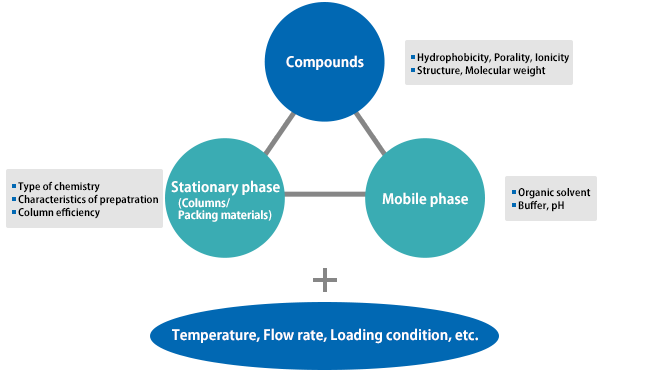In most cases, HPLC method development requires expertise and experience, which takes time and effort. Quick method development enables research and development to speed up. Anybody can quickly and easily develop a method if method scouting to consider separation conditions comprehensively can be manualized.
When method scouting is performed, the characteristics of the compounds, stationary phase (columns/packing materials), and mobile phase affect the separation results, as shown in the figure below. As the separation characteristics of compounds cannot be changed, optimization focuses on the stationary and mobile phases.

Before method optimization, information related to the compounds and analysis conditions is collected. Method scouting is effective if this information is not available. Method scouting can be used for comprehensive consideration of the analysis conditions, such as the mobile phase and column. Setting the basic conditions by method scouting and optimization of the mobile phase and column conditions enables quick development of methods.

In method scouting for reversed-phase HPLC, the mobile phase conditions, such as pH of buffers (solutions) other than organic solvents, affect the separation results. Therefore, the number of points to consider during method scouting increases. Short columns of 50 mm with sufficient length to finish the analysis in a short time are suitable, when many points need to be considered. The Triart series, with excellent peak shape and excellent durability, has various sizes available for use during method scouting. Quick method scouting can be performed by combining Triart columns, organic solvents, and the pH of the mobile phase.

Selection of basal conditions
(Columns and Mobile phase)
Optimizing separation
(Establishing a final method)
Optimization of conditions is performed based on the results of method scouting. The resolution and retention time are optimized by considering the ratio of mobile phase, gradient slope, addition of an organic modifier, column temperature, etc.
Although gradient elution is effective for analyzing multiple components, it requires time for equilibration of the column during every analysis. When considering the gradient slope, the final composition of the gradient is decided to allow elution of the components with the longest retention times, and the initial composition of the gradient allows retention of components with short retention times. Using a gentle gradient slope to improve resolution and/or a steep gradient slope to accelerate elution time can realize preparative improvement and save analytical time. The concentration of organic solvent, which is 15%–20% lower than that used to elute the initial component in gradient mode, is considered at the beginning of the transition to isocratic mode based on the results of method scouting.
gradient slope optimization in analysis of commercially available cold medicine extract

| Column | Hydrosphere C18 (5 μm, 120 Å) 150 X 4.6 mmI.D. |
|---|---|
| Eluent | A) 20 mM phosphate buffer (pH 2.5) B) methanol |
| Flow rate | 1.0 mL/min |
| Temperature | 37 ℃ |
| Detection | UV at 210 nm (0-15 min), 235 nm (15-25 min) |
To improve preparation, the addition of an organic modifier, such as tetrahydrofuran, may be effective. Adding an organic modifier to the mobile phase without changing the total volume of organic solvent could improve preparation by changing the selectivity.
